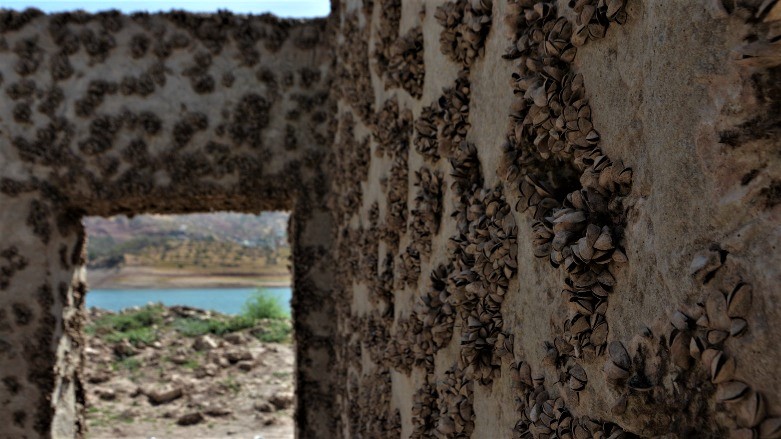Low water levels uncover ruins of village submerged for decades beneath Kurdistan’s Duhok Dam

ERBIL (Kurdistan 24) – A significant drop in water level caused by drought has uncovered ruins of a village that has been underwater for 36 years, when the land was flooded to construct the dam, located two kilometers north of Duhok city.
Only a few minutes' drive from city streets, the dam boasts beautiful views of the deep, blue body of water surrounded by hills, trees, and some secluded summer homes.
This year, however, one familiar with the local landscape will notice at a first glance that the water level is noticeably lower because of current hot, dry conditions.
The next most obvious additions are the now visible remains of a portion of a village that many simply did not know existed or else had long forgotten about.

The village was known Giri Qasruki and was inhabited up until its evacuation in 1985 to make way for the dam, largely to boost local irrigation. It was inhabited by members of the Doski tribe, one of the largest in Duhok province.
Former Giri Qasruki resident Ahmed Doski recalls that the village once had about a dozen families, a school, a mosque, and several orchards.
“The old village is no longer recognizable, but I suspect that the building which has become visible due to the low water level was the school, located on a hill, and the house of two brothers,” he said.

Karzan Mohammed Bamarni, who holds a Master’s degree in history, explained that the village was originally was built in the 1960s and 1970s. When the dam was constructed, however, the residents had to be evacuated and move to a new village that was built for them in another location, also named Giri Qasruki.
The appearance of the ruins now attracts many locals who walk out along ground that has been submerged for decades to take photographs and see it for themselves before winter arrives, the rainfall of which could very well swallow up the village once again.
For now, the features of the walls look surprisingly well preserved and untouched by anything but water, despite clusters of marine shellfish covering much of them.

Duhok Dam Manager Farhad Mohammed Taher told Kurdistan 24 that the water level has gone down more than 7 meters in 2021.
When construction was completed in 1988, it stood 60 meters high. Currently, 15 percent of its water is purified, bottled, and used for drinking.
The draught of 2021 has been described by many local farmers as one of the worst to hit the region in recent memory, urging the Kurdistan Regional Government (KRG) to allocate money for the construction of 12 new dams, including three in Duhok province.
Read More: Erbil governor: KRG will build dams to end water shortage crisis
Erbil Governor Omid Khoshnaw stressed at the time that it was crucial to the local economy that water should not be wasted and that the Council of Ministers had formed a special committee to deal with the unfolding water crisis.
